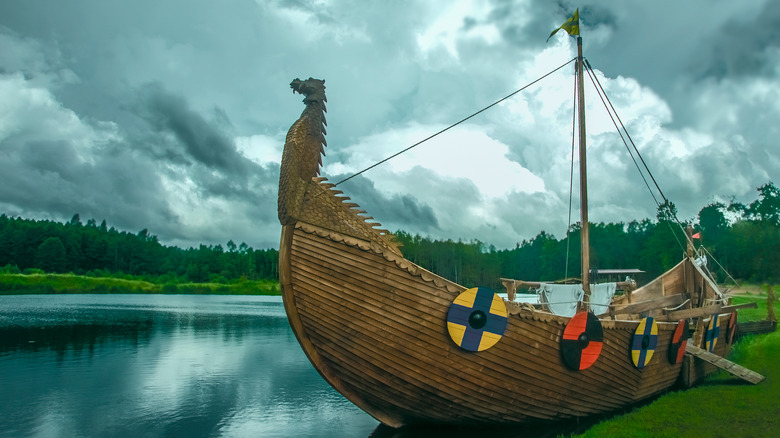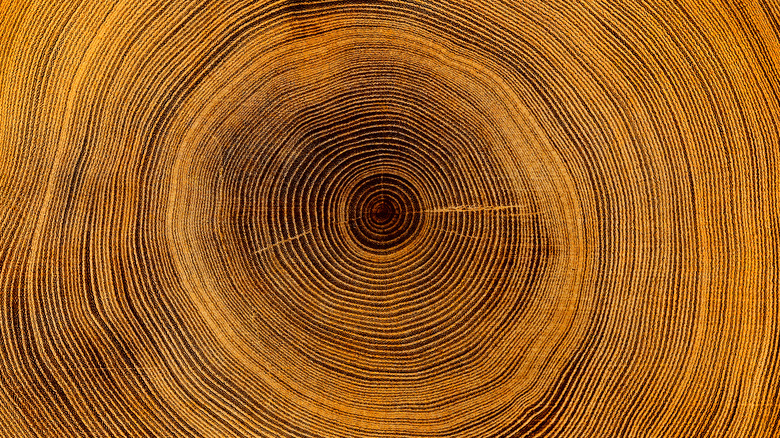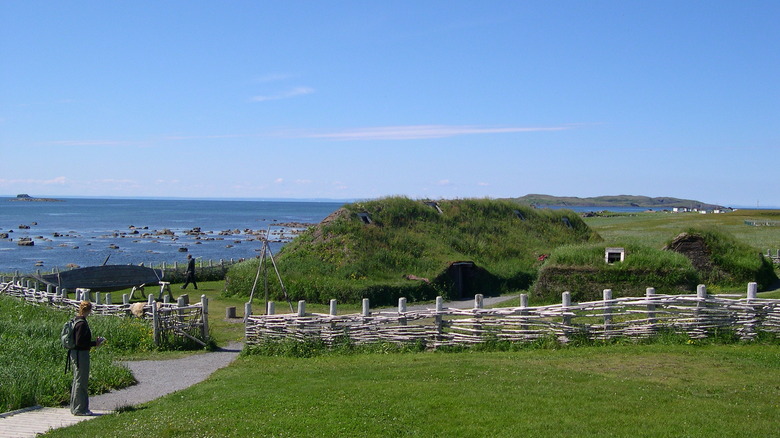What We Know About The Vikings Who Landed In North America Before Columbus
"In 1492 Columbus sailed the ocean blue." How's that for a bit of nursery rhyme-sounding school-age propaganda? If you're over a certain age, this little ditty is likely how you remembered how one valiant Italian led a fleet of ships to veer off course, mislabel hundreds of indigenous tribes as "Indians," decimate locals with typhoid, smallpox, measles, and the flu (per The Washington Post), and pave the way for civilization-slaughterers Cortés (the Aztecs in 1521, per History) and Pizarro (the Incas in 1533, per History). Effort has been made in recent years to untangle the inaccurate historical hero worship directed at Columbus, especially in regard to his "discoveries."
Enter: the Vikings. It's been long-speculated that these multinational Northmen from modern-day Scandinavia were the first Europeans to make it to "the New World," long before Columbus. Reason being: Vikings were master sailors. In rapid succession, from about 790-1100 CE, they traveled, traded, colonized, and pirated from Norway and Sweden down to Germany and France, out to Finland and Russia, up to England, Scotland, and even out to Iceland and Greenland. In fact, as World History says, Vikings were Iceland's original settlers, when Norman (Viking settlers in France) Ingólfr Arnarson founded Reykjavík in 874.
And now? A recent find in L'Anse aux Meadows in the far northeast of Newfoundland, Canada, provides the first proof-positive evidence that these sea-fearing progenitors did indeed make the journey all the way across the Atlantic.
Solar flares left a fingerprint on Viking homes
The find, originally published in Nature in October 2021, targeted a seaside Viking settlement at L'Anse aux Meadows, along the coast of Newfoundland, that overlooks the Atlantic Ocean. Radiocarbon-dating efforts, which check the age of organic material by measuring the decay of radiocarbon isotopes, had previously dated the Viking settlement to somewhere within 793 and 1066 CE, per Science. The new study, however, pinpoints the date to exactly 1021 CE.
How did we get such a precise age from long-dead wood? Solar flares. There was a super strong burst of solar energy in 993 CE that left a permanent radioactive imprint on every living tree on Earth that year. The imprint lives in the tree ring from that year in the form of carbon-14. Trees produce one ring per year, and we can count their age this way. Researchers simply counted out 28 rings from 993 CE to the last year of the tree's life before it was chopped down: 1021 CE. Trees, of course, stop growing once dead. This means that the Vikings might have settled in the area a bit before the tree was chopped down to make their houses and such, but 1021 is the latest date they arrived.
This method of radiocarbon dating was used previously to date the construction of a chapel in Switzerland (per Cambridge Press) and a volcanic eruption between China and North Korea (also per Cambridge Press).
A complete Viking settlement along the coast
How do we know the Vikings did all this? To start, the trees were cut with metal axes, which were unavailable to the indigenous tribes in the area at the time. The Guardian states of the radiocarbon-dated wood, "They had all been modified by metal tools, evident from their characteristically clean, low-angle cuts."
More important and impressive, though, the Vikings' signature timber-framed and turf-roofed houses still populate L'Anse aux Meadows' peat-bog land, which is now a designated UNESCO World Heritage Site. There are three houses in total with interior fireplaces and entrances of Norse design, a forge, four workshops, evidence of iron production and woodworking, and about 800 total Norse artifacts of wood, bronze, bone, and stone. There's even evidence that the Vikings sailed further south, lending credence to the idea that they and locals intermingled. All in all, the site is a typical, tiny Viking hamlet that likely thrived within 990 and 1050 CE.
It's especially amazing that this discovery occurred not through any of the site's "artifacts," but "just the offcuts or refuse of Viking activity," as Michael Dee, lead researcher at the University of Groningen, is quoted on Science. In other words, the radiocarbon-dated wood was basically trash, or unused materials that the Vikings didn't need.
This makes sense, though, because timber might have been the reason the Vikings went there anyway. They likely island-hopped from Iceland to Greenland, then Greenland to Canada. And in Greenland, timber is comparatively scarce.
The old Icelandic sagas proven true
The truly amazing thing about the find at L'Anse aux Meadows is that it corroborates the stories in the Icelandic Sagas, which include (per the Icelandic Literary Center) the "Sagas of Kings," the "Legendary Sagas," the "Contemporary Sagas," and (per The Guardian) stories of Leif Ericsson the Viking explorer. These stories were collected and written down by a variety of authors between 1190-1320 CE, as another Guardian article says. And what years did the events in these stories take place? From 950-1050 CE, exactly when the settlement at L'Anse aux Meadows was built. During this time, Leif established a settlement at what the Icelandic Vikings called "Vinland," which looks exactly like the Newfoundland hamlet that we now know dates to 1021 CE.
In short, myth has become true. Or at least, we've intercepted the facts behind Icelandic tales of heroes, trolls, and kings early enough to see them as more than mere fiction. There are fictional elements, of course, but they're mingled with historical fact.
In turn, this brings to light tons of questions about historical facts nested in Scandinavian tales like "Beowulf" (written in Old English around 1000 CE) and original Norse tales of Odin, Thor, Freyr, Tyr, and Loki first written down in "The Poetic Edda" sometime 1220-1270 CE (per World History). Such stories have become some of the most important pieces of cultural identity for Iceland and the Viking heritage.



